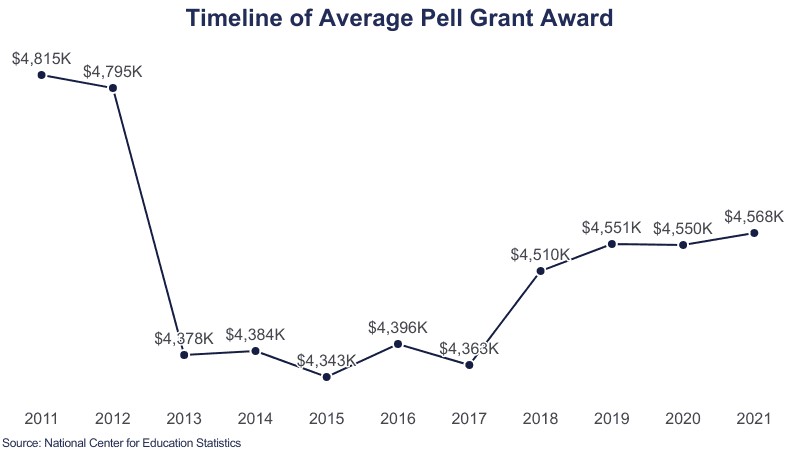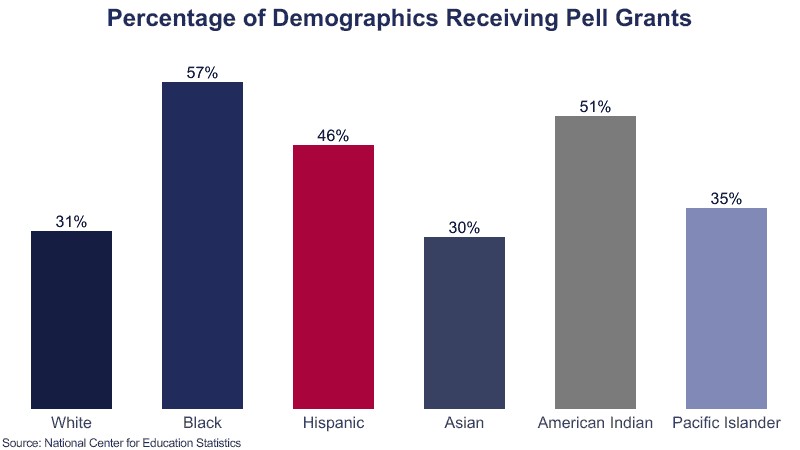The Pell Grant is a crucial financial aid program for students pursuing higher education in the United States. It provides need-based grants to eligible undergraduate students, helping them afford the rising costs of college. A common question among prospective students and their families is, “How Much Is The Pell Grant?”. This article breaks down the Pell Grant, exploring factors that determine the award amount, average awards, and maximum limits.
Pell Grant Award Determination and Financial Need
Pell Grant awards are primarily based on a student’s Expected Family Contribution (EFC), which is calculated using information from the Free Application for Federal Student Aid (FAFSA). The FAFSA considers factors such as family income, household size, and the number of dependents.
As a general rule, the lower your EFC, the higher your Pell Grant award will be. A significant portion of Pell Grant funds goes to students from low-income families.
- A large majority, 51% of Pell Grant funds, are awarded to students whose families earn less than $20,000 annually.
- 39% of Pell Grant recipients come from families with an annual income between $20,001 and $50,000.
- Only a small percentage, 6%, of Pell Grant recipients come from families that earn over $60,000 annually.
The following table illustrates how the number of recipients varies based on their Expected Family Contribution (EFC) and the amount of Pell Grant they receive:
| Expected Family Contribution (EFC) | Number of recipients who receive over $5,000 of the Pell Grant |
|---|---|
| $0 | 1,311,565 |
| $1 – $200 | 196,021 |
| $401 – $600 | 72,414 |
| $801 – $1,000 | 14,253 |
| $1,401 – $1,600 | 10,717 |
| $2,001 – $2,200 | 3,917 |
| $2,401 – $2,600 | 925 |
| $3,001 – $3,200 | 5 |
| $3,601 – $3,800 | 0 |
| $4,001 – $4,200 | 0 |
| $4,401 – $4,600 | 1 |
| $4,801 – $5,000 | 0 |
| $5,001 – $5,200 | 1 |
| $5,201-$5,300 | 1 |


Pell Grant Award Amounts by School Type
The type of school you attend can also influence the average Pell Grant award amount. Public colleges and universities receive the majority of Pell Grant funds.
- On average, a student at a public 4-year university receives a Pell Grant award of $5,320.
- The average Pell Grant award for a student at a public 2-year university is $4,414.
- Private 4-year university students receive an average Pell Grant of $5,602.
- Private 2-year university students receive an average of $5,727.
Looking at the distribution of funds across different types of institutions:
- 71% of Pell Grant funds go to public schools.
- 16% of Pell Grant funds go to private for-profit schools.
- 13% of Pell Grant funds go to private non-profit schools.
The Pell Grant can cover a varying percentage of the Cost of Attendance (COA) depending on the school type:
| School Type | Cost of Attendance (COA) | Percent of COA covered by Maximum Pell Grant ($6,895) |
|---|---|---|
| Public 2-year (in-state prices, off-campus housing) | $20,803 | 31.2% |
| Public 2-year (in-state prices, living with family) | $11,320 | 57.4% |
| Public 4-year (in-state prices, living on campus) | $25,048 | 25.9% |
| Private 4-year (living on campus) | $43,873 | 14.8% |
Pell Grant Maximum Award and Lifetime Limit
The maximum Pell Grant award changes annually.
- The maximum Pell Grant award for the current year is $6,895.
There is also a limit to how long you can receive Pell Grant funding. You can receive up to 100% of your Pell Grant award for a maximum of 6 years (equivalent to 12 semesters). In some instances, students may receive less than or more than 100% of the maximum award in a given year, with adjustments made in subsequent years to balance the total amount received.
Pell Grant Amounts by State
While state residency doesn’t directly determine the Pell Grant amount, there are variations in the average award per recipient across different states. This is due to differences in the income levels and financial needs of students in each state. The Expected Family Contribution (EFC) is the primary factor.
- California has the highest number of Pell Grant recipients at 938,931.
- Wyoming has the fewest Pell Grant recipients at 7,545.
- Mississippi has the highest average Pell Grant award at $5,505.
- New Hampshire has the lowest average Pell Grant award at $3,374.
| State | Total Recipients | Average Award per Recipient |
|---|---|---|
| Alabama | 125,913 | $5,028 |
| Alaska | 10,150 | $4,583 |
| Arizona | 241,734 | $4,779 |
| Arkansas | 64,697 | $5,120 |
| California | 938,931 | $5,018 |
| Colorado | 115,544 | $4,648 |
| Connecticut | 77,065 | $4,466 |
| Delaware | 17,385 | $4,578 |
| District of Columbia | 39,816 | $4,802 |
| Florida | 489,472 | $5,049 |
| Georgia | 228,026 | $4,974 |
| Hawaii | 17,845 | $4,901 |
| Idaho | 43,130 | $5,056 |
| Illinois | 264,460 | $4,816 |
| Indiana | 150,822 | $4,702 |
| Iowa | 60,247 | $4,887 |
| Kansas | 57,929 | $4,804 |
| Kentucky | 93,712 | $4,847 |
| Louisiana | 102,716 | $5,038 |
| Maine | 23,930 | $4,825 |
| Maryland | 104,443 | $4,450 |
| Massachusetts | 122,588 | $4,875 |
| Michigan | 194,896 | $4,686 |
| Minnesota | 116,995 | $4,443 |
| Mississippi | 75,904 | $5,505 |
| Missouri | 125,404 | $4,832 |
| Montana | 15,469 | $4,926 |
| Nebraska | 35,979 | $4,682 |
| Nevada | 41,130 | $4,518 |
| New Hampshire | 58,917 | $3,374 |
| New Jersey | 160,110 | $5,093 |
| New Mexico | 44,156 | $4,667 |
| New York | 455,599 | $5,366 |
| North Carolina | 203,124 | $4,996 |
| North Dakota | 11,365 | $4,934 |
| Ohio | 205,560 | $4,719 |
| Oklahoma | 81,189 | $4.886 |
| Oregon | 77,275 | $4,644 |
| Pennsylvania | 216,098 | $4,934 |
| Rhode Island | 28,675 | $4,793 |
| South Carolina | 91,246 | $4,967 |
| South Dakota | 19,066 | $4,657 |
| Tennessee | 133,225 | $5,046 |
| Texas | 577,542 | $4,996 |
| Utah | 125,681 | $5,008 |
| Vermont | 10,641 | $4,693 |
| Virginia | 170,632 | $4,880 |
| Washington | 104,023 | $4,877 |
| West Virginia | 50,002 | $4,842 |
| Wisconsin | 95,719 | $4,604 |
| Wyoming | 7,545 | $4,783 |
Pell Grant Averages by Demographics
Pell Grant awards also show some variation based on race and gender. Data from 2015-2016 indicates the following:
- The average Pell Grant award for White students is $4,661.
- The average Pell Grant award for Black students is $4,790.
- The average award for Hispanic students is $5,049.
- Asian students receive the largest Pell Grants on average, at $5,437.
- American Indian recipients averaged $4,531.
- Individuals in the “other” category or those identifying with two or more races averaged $4,920.
- Men and women receive the same average Pell Grant award of $4,790. However, women are more likely to receive the Pell Grant in the first place.
- 34% of all male college students received the Pell Grant.
- 43% of all female college students received the Pell Grant.
Conclusion
Understanding how much you can receive from the Pell Grant involves considering your Expected Family Contribution (EFC), the type of school you plan to attend, and the maximum award limits set by the government. While the average Pell Grant award can provide a helpful estimate, remember that your individual award may vary. Filling out the FAFSA is the first step to determining your eligibility and potential award amount, and it is a crucial step in making college more affordable.
Sources
- Education Data Initiative
